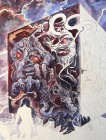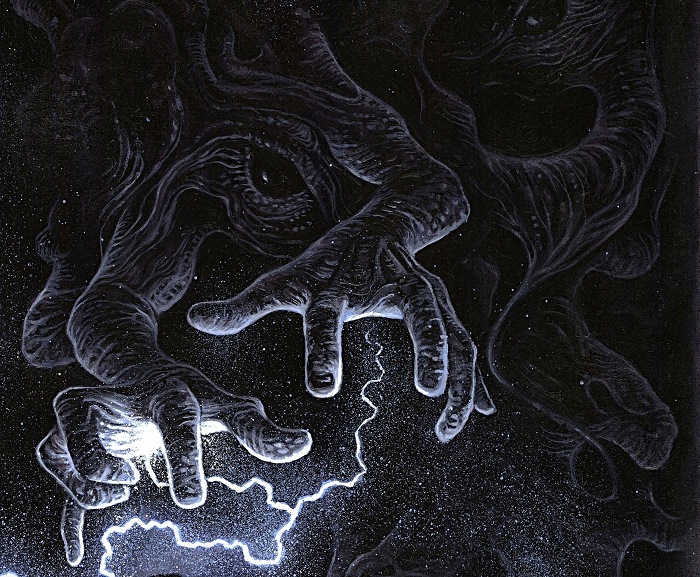Illustration for the Horror Pulp Series Vampira, Traumzeit-Dämonen (Dreamtime Demons), 2011
“Sydney, Nielsen Park.
Ein Lied war verstummt.
Auch hier auf dem felsigen Plateau, in den eingemeißelten, uralten Symbolen, in denen sich das Dunkel der Nacht spiegelte.
Überall rundum lag Schnee, der am Abend gefallen war. Eine fingerdicke Schicht.
Finger…Jaaa…!
Ein Finger nach dem anderen kroch aus dem harten Stein, formte und blähte die Asche, die hier vor Wochen niedergeregnet war, bis eine schwarze, verbrannte Hand und ein schwarzer, verbrannter Arm sichtbar wurden und eine geballte Faust – ganz Drohung – sich zum Himmel ballte.
Der plötzliche Temperatursturz ließ die sonst auch nachts üblichen Parkbesucher fernbleiben.
SCHADE…!
Das nahe Rauschen des Meeres bildete die einzige Geräuschkulisse.
Eine zweite Hand, ein zweiter Arm wurden sichtbar. Dann Kopf und Schulter. Wie verbrannt oder zerschmolzen auch sie. Kohleschwarz. Hart und doch geschmeidig. STARK.”
Adrian Doyle (Manfred Weinland), Vampira vol. 13, Traumzeit-Dämonen, © Bastei
Der pulp novel will be published on october 18 – with my cover illustration, but unfortunately without this drawing because it was forgotten by the typesetter. The drawing was published two months later in no. 17.
Vampira Vol. 13, Traumzeit-Dämonen (Dreamtime Demons) – The Making of a Pulp Cover Illustration
“In diesem Augenblick materialisierte vor ihr etwas, das die Unwirklichkeit verdichtete: Ein gewaltiger über dem roten Sand schwebender Quader, der aussah wie ein Klotz aus tonnenschwerer Dunkelheit! Die ganze Schwärze des Universums schien an diesem einen Punkt zusammengeballt zu sein, in einen Würfel gepresst, dessen Kanten und Konturen geschliffen scharf wirkten.
Lilith stockte der Atem Alle ihre Sinne konzentrierten sich auf diesen Block aus Finsternis, aus dessen Unterteil plötzlich gezackte Blitze in den Wüstenboden stießen und Sandfontänen aufwarfen. Lilith wurde von ein paar der “elektrisch” aufgeladenen Körnern getroffen. Sie prasselten gegen die Hülle des Symbionten, der die Form eines rückenfreien, vorn aber bis zum Hals geschlossenen Catsuits angenommen hatte. (…)
Die äscherne Aura hüllte Lilith erneut ein. Eng anliegend wie eine dritte Haut, wenn man den Symbionten als zweite einstufte. (…) Zentimeter trennten Lilith noch von dem schwebenden Koloss, in dem sich – sie sah es jetzt deutlich – schreckliche, schemenhafte Gestalten tummelten.(…) Und wieder machte sie einen Schritt, den sie gar nicht wollte. Berührte noch nicht selbst, aber mit der äschernen Aura das Domizil der entarteten Wondjinas! (…)
Vor Lilith schnellte etwas aus dem dunklen Vorhang. Etwas, das wie ein narbiger, furunkelübersähter, eiternder Arm aussah, aber keiner sein konnte. Es war nur der Abdruck eines Dings, das dort, woher es auf Lilith zustieß, keine Form besaß. (…) Immer mehr Arme und andere, menschlichen Extremitäten nachempfundene Extremitäten stießen aus em nachtschwarzen Quader.”
From: Adrian Doyle (Manfred Weinland), Traumzeit-Dämonen (Dreamtime Demons) und Apokalypse (Apocalypse), Vampira Bd. 13 und 14, © Bastei
The original cover illustration for volume 13 of the horror pulp series Vampira from 1995 was based on a brief description by the editor: Australian outback, in the foreground the series’ protagonist, dressed in a black, back free catsuit, in the backgound a huge, black, hovering cube, sending flashes of lightning to the red desert below; in its inside shadowy demons.
What I had in my mind when I created the painting back then was a little bit of a mixture between Caspar David Friedrich, Edgar Ende and Kubricks 2001 (the black monoliths), a rather unspectacular, calm scene. The deep blackness of the cube was more important to me than the demons, and because of that I only hinted at them with a few brushstrokes.
I do like some things about the painting, but in general it did not turn out as I imagined, and the figure in the foreground has its weaknesses, too (a really big head, for example). The cube was digitally lightened for print, with the result that neither the monolith was black as it should have been, nor the demons became more recognisable (simply because i did not really paint them).
The new edition of the series in 2011 provided the opportunity to paint the same scene again with quite a different approach – less like a Caspar David Friedrich painting and more dramatic, the flashes of lightning more vivid, the cube much closer to the foreground and really black, but without making the demons disappear in this blackness.
- Erste Skizze
- Vorzeichnung
- Vorzeichnung
- Vorzeichnung, auf Malkarton übertragen
The pencil drawings are DIN A4; the finished drawing was enlarged and transfered to painting cardboard (40 x 55 cm). For the first, rather sketchy colour layer I always use acrylyc, basically to try different colours and to define light and shadow.
- Beginn der Acrylfarben-Untermalung
- Acrylfarben-Untermalung, zur Hälfte fertig
- Arcylfarben-Untermalung, fertig
After I had finished the acrylic layer, I did not like the demons’ claws anymore and changed them to more human looking hands, using my own hands as a reference.
- Referenzfoto für Hand
- Vorzeichnung für Hände
- Neue Zeichnung der Hände auf Malgrund übertragen
- Neue Acryl-Untermalung der Hände
On top of the acrylic paint came two complete layers of oil paint plus additional details. For the “ashlike aura”, as it is described in the novel, and the sparks of light I used toothbrushes. The last step was to paint the whites cores of the lightning flashes.
- Erste Ölfarbenschicht, zu einem Drittel fertig
- Erste Ölfarbenschicht, Detail
- Erste Ölfarbenschicht, fertig
- Zahnbürsten zum Sprenkeln
- Zweite Ölfarbenschicht, Hintergrund fertig
- Blitze
- Fertiges Bild
The pulp novel was published on october 18.
Title Page for the Pulp Series 2012 – Das Jahr der Apokalypse, 2011
- Bleistiftskizze
- Fertige Zeichnung
- Gedruckte Rotaseite
2012 – Das Jahr der Apokalypse (The Year of the Apocalypse) is an adventure/mystery pulp mini-series published by Bastei since September 6, 2011. It deals with the apocalypse allegedly predicted by the Mayan calendar.
To create the ink drawing for the interior title page (The so called “Rota-Seite”) I was given a series synopsis, a list of possible subjects and a few compulsory subjects: the Maya plaque and stele, the Easter Island statue and some Central American pyramids (I chose Uxmal and Chichen Itza). The first sketch was improved according to further suggestions by the editor, Michael Schönenbröcher. The vignettes are used as chapter headers.
More information about the series here
More pulp series title pages here .
Rota-Seite: © Bastei-Lübbe
Illustrations for Die Herren der Zeit (The Lords of Time) by Helmut W. Pesch, 2000
 The novel, published in paperback by Bastei Lübbe, is the sequel to The Rings of Power – not quite so close to the Lord of the Rings as its predecessor (in the second part there’s a lot of time travelling going on), but still with substantial and, as in The Rings of Power, deliberately used Tolkien reminiscences.
The novel, published in paperback by Bastei Lübbe, is the sequel to The Rings of Power – not quite so close to the Lord of the Rings as its predecessor (in the second part there’s a lot of time travelling going on), but still with substantial and, as in The Rings of Power, deliberately used Tolkien reminiscences.
The original drawings are missing, therefore I scanned the book pages.
Illustrations for a John Sinclair Anniversary Paperback Edition, Part 4 (Vol. 17–21), 1998/99
- Bd. 17/1, Der Würfel des Unheils
- Bd. 18/1, Die Mörder-Blumen
- Bd. 19/3, Flucht in die Schädelwelt
- Bd. 19/4, Im Land des Vampirs
- Bd. 20/1, Die fliegenden Särge
- Bd. 20/3, Das Elexier des Teufels
- Bd. 20/4, Die Nacht der flammenden Augen
- Bd. 20/5, Der Gigant von Atlantis
- Bd. 20/8, Die Teufelsuhr
- Bd. 21/1, Myxins Entführung
- Bd. 21/2, Wer mit Gedanken töten kann
- Bd. 21/3, Der Spiegel-Dämon
- Bd. 21/5, Medusas Rache
- Bd. 21/6, Der Zombie-Bus
- Bd. 21/8, Die Bestien aus dem Geister-Sumpf
A selection of 16 out of 50 illustrations for the John Sinclair anniversary paperbacks vol. 17–21. The edition was was chronological reprint of the original horror pulp series by Jason Dark (Helmut Rellergerd). Each book included 8 novels, the interior illustrations replaced the original color covers but were created independantly from their predecessors.
Altogether I illustrated 21 volumes with 169 drawings; more images in part 1, 2 und 3.
Overview of all John Sinclair books at gruselromane.de.
Illustrations for a John Sinclair Anniversary Paperback Edition, Part 3 (Vol. 12–16), 1997
- Bd. 12/3, Die Geisterhand
- Bd. 3/4, Todeszone London
- Bd. 13/1, Kino des Schreckens
- Bd. 13/2, Der Hexer von Paris
- Bd. 13/5, Knochensaat
- Bd. 14/4, Das Buch der grausamen Träume
- Bd. 14/5, Tigerfrauen greifen an
- Bd. 14/6, Schrei, wenn dich die Schatten fressen
- Bd. 14/7, Die Werwolf-Insel
- Bd. 15/4 Die Höllenkutsche
- Bd. 16/3, Das letzte Duell
- Bd. 15/7, Die Bestie von Soho
- Bd. 15/8, Hügel der Gehenkten
- Bd. 16/5, Das Eisgefängnis
- Bd. 13/6, Die Horror-Cops
A selection of 16 out of 32 illustrations for the John Sinclair anniversary paperbacks, vol. 12–16. The edition was chronological reprint of the original horror pulp series by Jason Dark (Helmut Rellergerd). Each book included 8 novels, the interior illustrations replaced the original color covers but were not supposed to imitate them in any way.
Altogether I illustrated 21 volumes with 169 drawings; more images in part 1, 2 und 4.
Overview of all John Sinclair books at gruselromane.de.
Illustrations for Die Ringe der Macht (The Rings of Power) by Helmut W. Pesch & Horst von Allwörden, 1997
 The novel was published in paperback by Bastei Lübbe paperback in 1997, and it is exactly what its title suggests: A deep bow to Tolkien.
The novel was published in paperback by Bastei Lübbe paperback in 1997, and it is exactly what its title suggests: A deep bow to Tolkien.When I read the first 100 pages of of the manuscript back then I was slightly irritated by by the extent of references to The Fellowship of the Ring, but once I had accepted the whole thing as a deliberate pastiche, and since the novel later on develops in quite another direction, my irritation abated. The authors know exactly what they do, especially Helmut W. Pesch, whose doctoral dissertation “Fantasy – Theory and History of a Literary Genre” from 1981 is the German standard reference book on the subject. Since I had read the study years ago, I was all the more glad when Bastei commissioned the illustrations for the novel.
The sequel Die Herren der Zeit (The Lords of Time) was published in 2000.
Illustrations for Der Hexer von Salem: Das Labyrinth von London (The Warlock of Salem: The Labyrinth of London) by Wolfgang Hohlbein, 1996
The novel is part of Wolfgang Hohlbeins Lovecraft-inspired book series Der Hexer von Salem (The Warlock of Salem). It was published in paperback by Bastei Lübbe in 1996 and included 15 full-page illustrations and a chapter vignette.




















































































